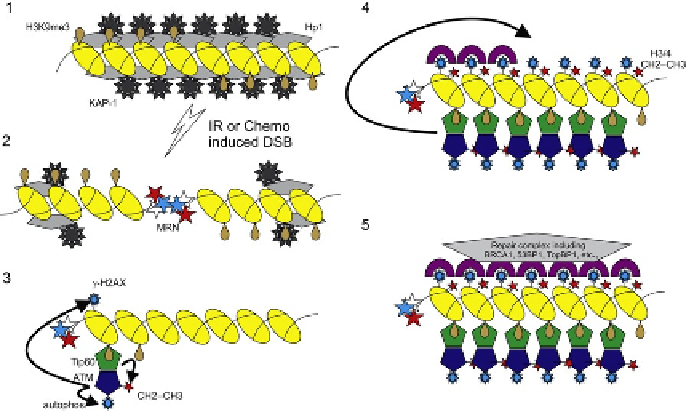Biology Reference
In-Depth Information
HP1 is an adapter molecule that is primarily responsible for maintaining
heterochromatin. KAP-1 was shown to actively regulate the decondensation
of chromatin surrounding DSBs when deactivated, likely by phosphorylation.
When a DSB occurs, the DNA is structurally opened and the MRN complex
recognizes this occurrence by an unknown mechanism. MRN binds the free
DNA ends. Then this action unmasks trimethylated H3 at K9 (H3K9me3) in
the vicinity of the DSB. In undamaged cells, Tip60 and ATM form a stable
complex and Tip60 is capable of recognizing H3K9me3 via its chromodomain,
which allows its recruitment to the DSB, along with ATM. Tip60 then acety-
lates ATM, which activates the preliminary kinase functions, and allows autop-
hosphorylation and the production of
g
-H2AX, which begins a cascade that
results in megabases of
g
-H2AX production around the DSB. In the same time
frame as ATM is activated, Tip60 begins to hyperacetylate H3 and H4 at
multiple residues, resulting in further chromatin relaxation
8
(
Fig. 1
).
F
IG
. 1. (1) DNA bound to chromatin tightly compacted and maintained by Hp1 and KAP-1.
(2) DSB occurs and MRN is recruited to DSB displacing Hp1 and KAP-1, revealing H3K9me3. (3)
Tip60 and ATM are recruited to H3K9me3. Tip60 acetylates and activates ATM. ATM induces
g
-H2AX and autophosphorylates. (4) MDC1 is recruited to
g
-H2AX, ATM is activated and extends
g
-H2AX, Tip60 acetylates H3/4. (5) MDC1 expands and binds to
g
-H2AX which recruits a plethora
of repair factors in conjunction with acetylated and methylated histones. Multiple steps are then
ready to proceed, including HRR end resection, chromatin remodeling and the rest of the HRR
mechanism.

